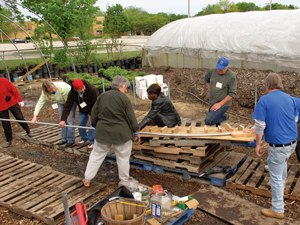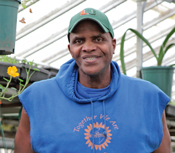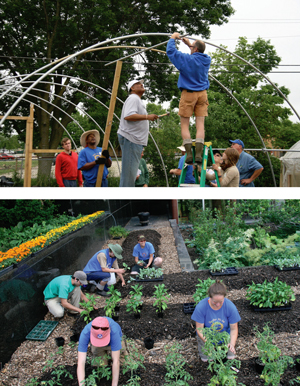Food, urban farms and our survival
By Starla Muhammad -Staff Writer- | Last updated: Dec 22, 2010 - 5:11:52 PMWhat's your opinion on this article?
With Blacks caught between no food and bad food, movement seeks to save lives

Participants at a Growing Power workshop. Photos: Courtesy of Growing Power
|
Studies show in poor and predominately Black neighborhoods, there is often greater access to “convenience” stores and fast food chains than to full service grocery stores.
“Anyone who has shopped for food in a poor urban neighborhood, in Oakland or elsewhere, knows how it goes: Twenty varieties of malt liquor, potato chips, and frozen burritos and one bruised-up, waxy apple,” noted an article on OaklandNorth.net. A 2009 study conducted by Hope Collaborative, found in a poor Oakland community one run-down supermarket but 32 liquor stores in one zip code.

Will Allen, CEO of Growing Power, Inc.
|
Lack of availability and access to healthy and nutritious foods, an overall food shortage and its correlation to sickness, disease and even death has sparked a need for a united effort to address these critical issues.
Activists, educators, religious institutions, non-profit organizations and ordinary citizens are tackling what has been deemed America's “urban food and health crisis” head-on by planting community gardens block by block in backyards, vacant lots, parks, front stoops, rooftops, windowsills or any available patch of open space.

Hoop house construction. (lower) Growing Power staff and volunteers install a garden.
|
According to the U.S. Department of Agriculture in 2007, 36.2 million U.S. households were considered food insecure, that number increased to 49.1 million in 2008. The USDA defines food insecurity as limited or uncertain availability of nutritionally adequate and safe foods or limited or uncertain ability to acquire acceptable foods in socially acceptable ways. The national average of food insecure households in 2008 was 14.6 percent and the numbers vary by household type with Black and Latino households at 25.7 and 26.9 percent respectively.
Growing tomatoes, lettuce, cucumbers and fresh herbs in the midst of bricks and concrete of a bustling metropolis, is not only feasible, but according to urban agriculturalists, this sustainable agriculture movement is the only way to combat a growing food and health crisis in this country.
Poor communities not only lack access to healthy food but in many cases there is little to no food available.
“There has never been a greater social and environmental need for community gardening,” shared Vicki Garrett, an organic gardener and projects coordinator of the American Community Gardening Association, based in Columbus, Ohio. The economic situation is leading to more hungry people. Food pantries and homeless shelters are struggling to keep up, said Ms. Garrett in an e-mail to The Final Call.
Urban food deserts and food injustice
“Food is the next frontier of the civil rights movement,” said Erika Allen of Growing Power Inc., in a recent online interview. Growing Power, a national non-profit organization headquartered in Milwaukee, is helping communities develop food centers and systems nationally and internationally through alternative growing methods.
Nationwide, in many poor, predominately-Black neighborhoods the nearest grocery store can be blocks or miles away, leaving few or no options for decent food. The phrase “food deserts” has been coined to describe these areas.
“Examining the Impact of Food Deserts on Public Health in Chicago,” a 2006 report published by the Mari Gallagher Research and Consulting Group defines a food desert as a large geographic area with no or distant grocery stores.
In examining Chicago, the report found over 600,000 people, mostly Black, lived in these food deserts and on average travelled the farthest distance to any type of grocery store. “Chicago's food deserts, for the most part, are exclusively African-American,” said the report.
A similar study done for Detroit in 2007, noted “over half a million Detroit residents live in areas that have an imbalance of health food options.” Detroit is nearly 82 percent Black. In Birmingham, Ala., which is over 73 percent Black, 88,000 people lived in food deserts.
The Gallagher report stated that in a typical predominately Black block in Chicago, the nearest grocery store is nearly twice the distance as the nearest fast food restaurant. “This means that, for African-Americans, it is much easier to access fast food than other types of food. Following a doctor's dietary recommendation is likely very difficult for the half million plus African-Americans who live in the 287 worst grocery-store-access tracts,” continued the report.
A follow-up report released in September said the number of people residing in Chicago area food deserts had decreased but that they remained large, affecting roughly 550,000 people today. Ms. Gallagher explains there are lessons to be learned from the food desert studies that in turn, can help formulate solutions.
There is not one single problem creating food deserts and therefore not one single solution, which is good news, because it means everybody can work toward a solution, said Ms. Gallagher to The Final Call. “It's not all about plopping in a big grocery store or chain store and besides those projects take a long time, so we want to make sure there are a myriad of solutions including non-traditional solutions being advanced.”
However, while Ms. Gallagher calls community gardens “important” she says they are not a year round grocery store solution. However, Dallas-based Gardeners In Community Development on its website notes that urban agriculture is three to five times more productive per acre than traditional large-scale farming and community gardens donate thousands of pounds of fresh produce to food pantries and involve people in processes that provide food security and alleviate hunger.
Residents of food deserts suffer the worst diet related problems say experts, therefore people must begin to take their health seriously and take steps to grow foods on their own, or through collaborative community efforts.
Poor diet, inferior foods equal sickness, increased care costs
People living in neighborhoods crowded with fast food and convenience stores but relatively few grocery or produce outlets are at significantly higher risk of suffering from obesity and diabetes, says the UCLA Center For Health Policy Research.
For Blacks in America, it is cause for greater alarm as statistics reflect that although making up only 13 percent of the population, Black adults are twice as likely to be diagnosed and suffer from heart disease, stroke, diabetes and obesity, all of which can be reduced dramatically by healthier eating and lifestyle change.
In 2008 obesity-related healthcare costs were approximately $147 billion. According to some estimates, that number could potentially escalate to $344 billion per year by 2018, or roughly 21 percent of total U.S. health costs. Data released by the Centers for Disease Control suggests that in adults, Blacks have a 51 percent higher prevalence of obesity than Whites. For youth, the prevalence for obesity among Blacks ages 12 to 19 increased from 38.7 percent in 2001-2002 to 49 percent in 2008-2009.
Let's Move, the national campaign to combat childhood obesity, spearheaded by First Lady Michelle Obama has become her personal crusade to address this issue. “Most folks don't grow their own food the way many of our parents and grandparents did.A lot of folks also just don't have the time to cook at home on a regular basis.So instead, they wind up grabbing fast food or something from the corner store or the mini-mart—places that have few, if any, healthy options,” said Mrs. Obama to the NAACP National Convention in Kansas City, Mo., earlier this year.
Among the several recommendations the Let's Move task force endorses is the planting of community gardens. Mrs. Obama, leading by example, helped plant a vegetable garden with D.C. area youth on the grounds of the White House in 2009.
Back to nature and better health
“I look at gardening as a way to help save our people, point blank,” notes Nathan Muhammad, a self-described agricultural engineer whose company specializes in the design and installation of gardens for corporate and residential clients.
Urban gardening or sustainable agriculture is becoming increasingly important because our reliance on outside interests and conglomerate retailers put a very vital need in jeopardy, he explained.
“There is a need for environmentally-conscious community members to become involved in sustainable gardening or agriculture projects in their neighborhoods,” Mr. Muhammad told The Final Call. The interest and popularity of gardening is also on the rise observe some.
According to Vicki Garrett, new membership in the American Community Gardening Association, has almost doubled over the last year and e-mails and phone calls have increased around 20 percent. “Web hits in 2008 were listed as 17,000 per month and they've been around 350,000 per month recently,” said Ms. Garrett.
Fifteen percent of the world's food is now grown in urban areas, said the United States Department of Agriculture. According to one source, there are as many as 18,000 community gardens in the U.S. and Canada alone, which can yield $500 to $1,200 worth of produce per year for a single family.
A personal or community garden is a way for people, especially the poor, to become more self-sufficient said Mr. Muhammad and though it takes work, the benefits are well worth it. People can begin with a small container garden or planting herbs and even vegetables in small pots. Neither option takes up much space and “it's no harder than maintaining a flower bed,” Mr. Muhammad explained.
Those who grow their own food have an added sense of security about what is going into their body for optimum health, say community garden advocates.
“Even before the economy became so bad, poor quality food from anonymous producers led to consumer concern about the sources of their food,” noted Ms. Garrett.
In volume 2 of his groundbreaking book, “How To Eat To Live,” the Honorable Elijah Muhammad writes, “There is no question. If we eat right, we live. If we eat the wrong foods, it shortens our lives,” said the patriarch of the Nation Of Islam. Nation of Islam Minister Louis Farrakhan is deeply concerned about the lack of access to healthy food and poor health in the Black community and recently declared 2011 the “year of the farm.” The Nation of Islam will focus on developing an independent sustainable way of providing healthy food through farming and gardening.
INSIDE STORIES AND REVIEWS
-
-
About Harriett ... and the Negro Hollywood Road Show
By Rabiah Muhammad, Guest Columnist » Full Story -
Skepticism greets Jay-Z, NFL talk of inspiring change
By Bryan 18X Crawford and Richard B. Muhammad The Final Call Newspaper @TheFinalCall » Full Story -
The painful problem of Black girls and suicide
By Charlene Muhammad -National Correspondent- » Full Story -
Exploitation of Innocence - Report: Perceptions, policies hurting Black girls
By Charlene Muhammad -National Correspondent- » Full Story -
Big Ballin: Big ideas fuel a father’s Big Baller Brand and brash business sense
By Bryan Crawford -Contributing Writer- » Full Story







 Click Here Stay Connected!
Click Here Stay Connected!








